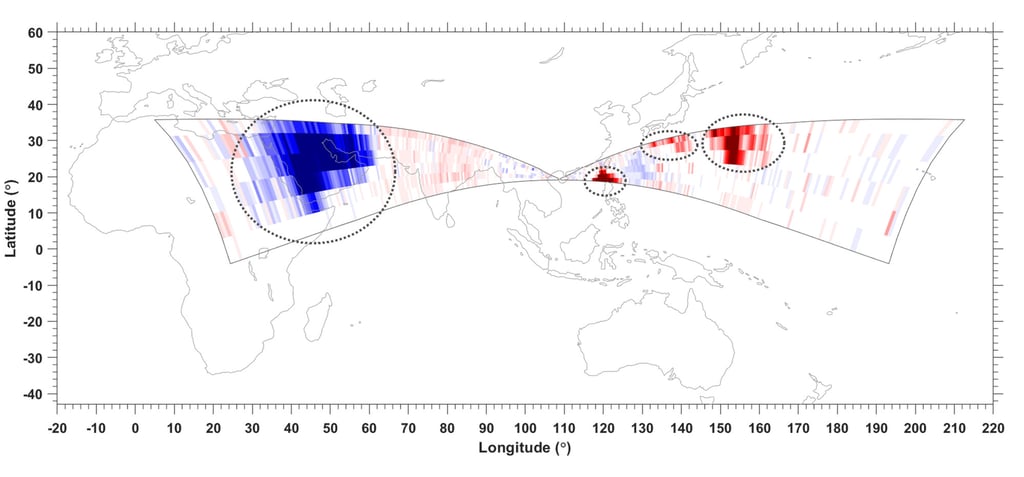Chinese scientists have claimed to have made a groundbreaking discovery using what is currently regarded as the world’s most powerful radar system. This system allows them to simultaneously detect equatorial plasma bubbles (EPB) over the Egyptian pyramids and the Midway Islands in the Pacific Ocean.
This development positions China as a leader in ionospheric research, and the country is now the first in the world to track such anomalies in real-time, according to Chinese media claims.
The radar, known as the Low Latitude Long Range Ionospheric Radar (LARID), was developed by the Institute of Geology and Geophysics under the Chinese Academy of Sciences and was installed last year.
It has the unique ability to detect plasma bubbles, “an anomalous weather phenomenon” that can disrupt satellite communications and GPS systems by interfering with the ionosphere — the part of Earth’s upper atmosphere populated by charged particles.
These plasma bubbles, which can grow to hundreds of kilometers in size, are typically seen in low-latitude regions.

They form when large amounts of electrons suddenly vanish from the ionosphere, creating vast electron-depleted zones. Until now, tracking and observing these bubbles in real time has been challenging.
The report claimed that the breakthrough came last year during a solar storm from November 4-6. The LARID system successfully detected radar echoes from plasma bubbles forming over North Africa and the Central Pacific.
The radar’s unprecedented detection range allowed scientists to monitor these bubbles as they formed and moved across regions separated by vast distances.
German Submarines For India! Will Navy’s ‘Cutting Edge’ Stealth Boats Float If ThyssenKrupp Sinks?
What makes this achievement particularly noteworthy is the scale of LARID’s capabilities. Located on Hainan Island in southern China, the radar’s detection range has tripled since its initial deployment, expanding from 3,000 km to nearly 9,000 km.
This extended range reaches approximately as far as Hawaii to the east or Libya to the west. Advances in signal processing and geophysical simulation models have made this possible.
F-16s “Sitting Ducks” For Russian MiG-31 Fighters? Putin Warns Of Consequences Over Fighting Falcons
Chinese researchers believe the discovery will have major implications for global communications and navigation systems, offering the potential to mitigate the negative impacts of plasma bubbles on satellite signals.
LARID operates with two high-frequency (HF) radar systems, oriented eastward and westward.
A research article by the Chinese Academy of Sciences, published in March 2024, highlights LARID’s capability to predict and issue alerts regarding ionospheric scintillations over an extensive area that spans from the Indian Ocean to the western Pacific.
LARID operates within the 8-22 MHz frequency range and comprises two radar subsystems, each equipped with 24 transceiver antennas facing east and west.
Its advanced, fully digital phased array system allows real-time adjustments to detection parameters such as frequency, range, and radar coding, enhancing its adaptability and effectiveness.
Potential For Strategic Military Applications
Traditional radar systems struggle with targets beyond the horizon due to the Earth’s curvature. In contrast, LARID utilizes high-power electromagnetic waves that bounce between the ionosphere and the ground, allowing it to overcome this limitation.
Previously, radar systems with such extensive over-the-horizon capabilities were deemed impractical due to the complexity of radio wave propagation and the impact of severe weather conditions like geomagnetic storms on signal clarity.
Despite these challenges, LARID has reportedly achieved notable success and has significant military implications. The detection of plasma bubbles can greatly affect modern military operations, particularly satellite communications and GPS systems.
Traditionally, the military has recognized the strategic value of understanding these phenomena, as evidenced by numerous studies supported by various global armed forces.
However, the absence of large-scale, persistent observation facilities over oceans has limited early warning and comprehensive monitoring capabilities. Yet, LARID’s success underscores the potential benefits of expanding this technology.
Chinese scientists have proposed establishing additional over-the-horizon radars in low-latitude regions worldwide, aiming to create a global network for seamless real-time monitoring of equatorial plasma bubbles.
This network would enhance early warning capabilities and improve understanding of these phenomena.
Similar over-the-horizon radar technologies have already been implemented by the Chinese military in a military context. Reports indicate the successful detection of stealth US-made fifth-generation fighter aircraft like the F-22. Some new PLA warships, such as the 055-type destroyers, are also equipped with radars capable of detecting stealth aircraft.
These radars utilize wavelengths that penetrate stealth coatings, potentially reaching detection ranges of hundreds of kilometers.
- Contact the author at ashishmichel(at)gmail.com
- Follow EurAsian Times on Google News